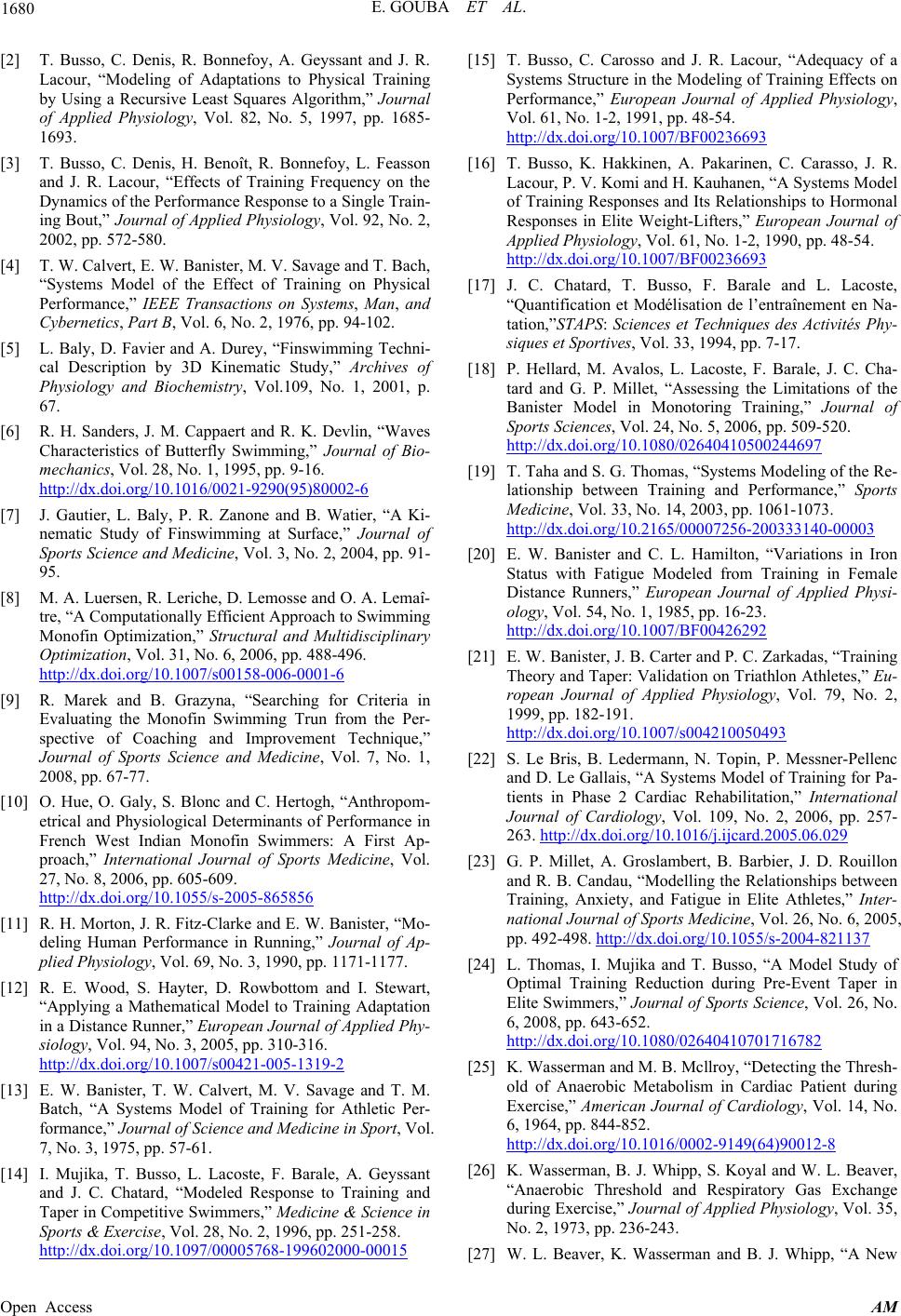
E. GOUBA ET AL.
1680
[2] T. Busso, C. Denis, R. Bonnefoy, A. Geyssant and J. R.
Lacour, “Modeling of Adaptations to Physical Training
by Using a Recursive Least Squares Algorithm,” Journal
of Applied Physiology, Vol. 82, No. 5, 1997, pp. 1685-
1693.
[3] T. Busso, C. Denis, H. Benoît, R. Bonnefoy, L. Feasson
and J. R. Lacour, “Effects of Training Frequency on the
Dynamics of the Performance Response to a Single Train-
ing Bout,” Journal of Applied Physiology, Vol. 92, No. 2,
2002, pp. 572-580.
[4] T. W. Calvert, E. W. Banister, M. V. Savage and T. Bach,
“Systems Model of the Effect of Training on Physical
Performance,” IEEE Transactions on Systems, Man, and
Cybernetics, Part B, Vol. 6, No. 2, 1976, pp. 94-102.
[5] L. Baly, D. Favier and A. Durey, “Finswimming Techni-
cal Description by 3D Kinematic Study,” Archives of
Physiology and Biochemistry, Vol.109, No. 1, 2001, p.
67.
[6] R. H. Sanders, J. M. Cappaert and R. K. Devlin, “Waves
Characteristics of Butterfly Swimming,” Journal of Bio-
mechanics, Vol. 28, No. 1, 1995, pp. 9-16.
http://dx.doi.org/10.1016/0021-9290(95)80002-6
[7] J. Gautier, L. Baly, P. R. Zanone and B. Watier, “A Ki-
nematic Study of Finswimming at Surface,” Journal of
Sports Science and Medicine, Vol. 3, No. 2, 2004, pp. 91-
95.
[8] M. A. Luersen, R. Leriche, D. Lemosse and O. A. Lemaî-
tre, “A Computationally Efficient Approach to Swimming
Monofin Optimization,” Structural and Multidisciplinary
Optimization, Vol. 31, No. 6, 2006, pp. 488-496.
http://dx.doi.org/10.1007/s00158-006-0001-6
[9] R. Marek and B. Grazyna, “Searching for Criteria in
Evaluating the Monofin Swimming Trun from the Per-
spective of Coaching and Improvement Technique,”
Journal of Sports Science and Medicine, Vol. 7, No. 1,
2008, pp. 67-77.
[10] O. Hue, O. Galy, S. Blonc and C. Hertogh, “Anthropom-
etrical and Physiological Determinants of Performance in
French West Indian Monofin Swimmers: A First Ap-
proach,” International Journal of Sports Medicine, Vol.
27, No. 8, 2006, pp. 605-609.
http://dx.doi.org/10.1055/s-2005-865856
[11] R. H. Morton, J. R. Fitz-Clarke and E. W. Banister, “Mo-
deling Human Performance in Running,” Journal of Ap-
plied Physiology, Vol. 69, No. 3, 1990, pp. 1171-1177.
[12] R. E. Wood, S. Hayter, D. Rowbottom and I. Stewart,
“Applying a Mathematical Model to Training Adaptation
in a Distance Runner,” European Journal of Applied Phy-
siology, Vol. 94, No. 3, 2005, pp. 310-316.
http://dx.doi.org/10.1007/s00421-005-1319-2
[13] E. W. Banister, T. W. Calvert, M. V. Savage and T. M.
Batch, “A Systems Model of Training for Athletic Per-
formance,” Journal of Science and Medicine in Sport, Vol.
7, No. 3, 1975, pp. 57-61.
[14] I. Mujika, T. Busso, L. Lacoste, F. Barale, A. Geyssant
and J. C. Chatard, “Modeled Response to Training and
Taper in Competitive Swimmers,” Medicine & Scienc e in
Sports & Exercise, Vol. 28, No. 2, 1996, pp. 251-258.
http://dx.doi.org/10.1097/00005768-199602000-00015
[15] T. Busso, C. Carosso and J. R. Lacour, “Adequacy of a
Systems Structure in the Modeling of Training Effects on
Performance,” European Journal of Applied Physiology,
Vol. 61, No. 1-2, 1991, pp. 48-54.
http://dx.doi.org/10.1007/BF00236693
[16] T. Busso, K. Hakkinen, A. Pakarinen, C. Carasso, J. R.
Lacour, P. V. Komi and H. Kauhanen, “A Systems Model
of Training Responses and Its Relationships to Hormonal
Responses in Elite Weight-Lifters,” European Journal of
Applied Physiology, Vol. 61, No. 1-2, 1990, pp. 48-54.
http://dx.doi.org/10.1007/BF00236693
[17] J. C. Chatard, T. Busso, F. Barale and L. Lacoste,
“Quantification et Modélisation de l’entraînement en Na-
tation,”STAPS: Sciences et Techniques des Activités Phy-
siques et Sportives, Vol. 33, 1994, pp. 7-17.
[18] P. Hellard, M. Avalos, L. Lacoste, F. Barale, J. C. Cha-
tard and G. P. Millet, “Assessing the Limitations of the
Banister Model in Monotoring Training,” Journal of
Sports Sciences, Vol. 24, No. 5, 2006, pp. 509-520.
http://dx.doi.org/10.1080/02640410500244697
[19] T. Taha and S. G. Thomas, “Systems Modeling of the Re-
lationship between Training and Performance,” Sports
Medicine, Vol. 33, No. 14, 2003, pp. 1061-1073.
http://dx.doi.org/10.2165/00007256-200333140-00003
[20] E. W. Banister and C. L. Hamilton, “Variations in Iron
Status with Fatigue Modeled from Training in Female
Distance Runners,” European Journal of Applied Physi-
ology, Vol. 54, No. 1, 1985, pp. 16-23.
http://dx.doi.org/10.1007/BF00426292
[21] E. W. Banister, J. B. Carter and P. C. Zarkadas, “Training
Theory and Taper: Validation on Triathlon Athletes,” Eu-
ropean Journal of Applied Physiology, Vol. 79, No. 2,
1999, pp. 182-191.
http://dx.doi.org/10.1007/s004210050493
[22] S. Le Bris, B. Ledermann, N. Topin, P. Messner-Pellenc
and D. Le Gallais, “A Systems Model of Training for Pa-
tients in Phase 2 Cardiac Rehabilitation,” International
Journal of Cardiology, Vol. 109, No. 2, 2006, pp. 257-
263. http://dx.doi.org/10.1016/j.ijcard.2005.06.029
[23] G. P. Millet, A. Groslambert, B. Barbier, J. D. Rouillon
and R. B. Candau, “Modelling the Relationships between
Training, Anxiety, and Fatigue in Elite Athletes,” Inter-
national Journal of Sports Medicine, Vol. 26, No. 6, 2005,
pp. 492-498. http://dx.doi.org/10.1055/s-2004-821137
[24] L. Thomas, I. Mujika and T. Busso, “A Model Study of
Optimal Training Reduction during Pre-Event Taper in
Elite Swimmers,” Journal of Sports Science, Vol. 26, No.
6, 2008, pp. 643-652.
http://dx.doi.org/10.1080/02640410701716782
[25] K. Wasserman and M. B. Mcllroy, “Detecting the Thresh-
old of Anaerobic Metabolism in Cardiac Patient during
Exercise,” American Journal of Cardiology, Vol. 14, No.
6, 1964, pp. 844-852.
http://dx.doi.org/10.1016/0002-9149(64)90012-8
[26] K. Wasserman, B. J. Whipp, S. Koyal and W. L. Beaver,
“Anaerobic Threshold and Respiratory Gas Exchange
during Exercise,” Journal of Applied Physiology, Vol. 35,
No. 2, 1973, pp. 236-243.
[27] W. L. Beaver, K. Wasserman and B. J. Whipp, “A New
Open Access AM